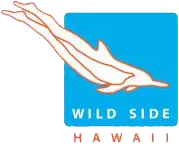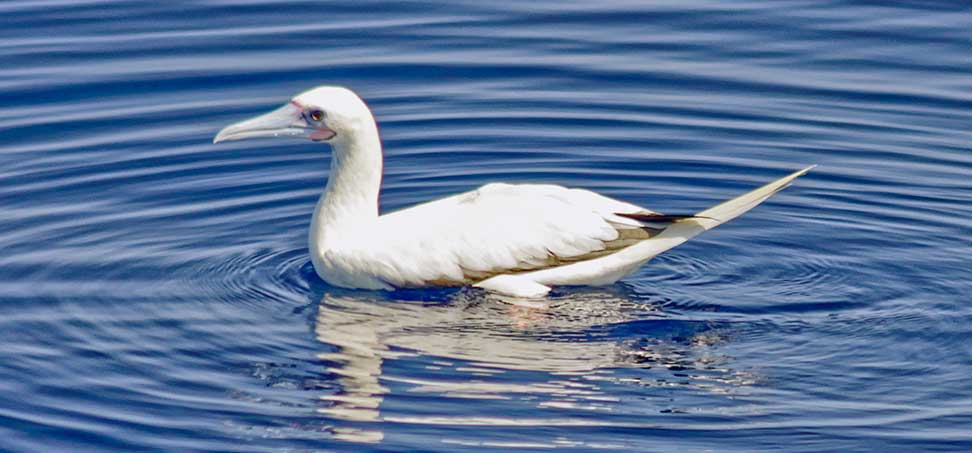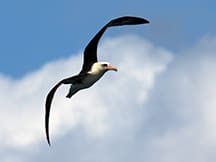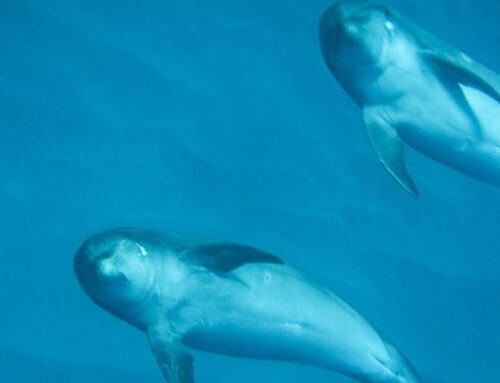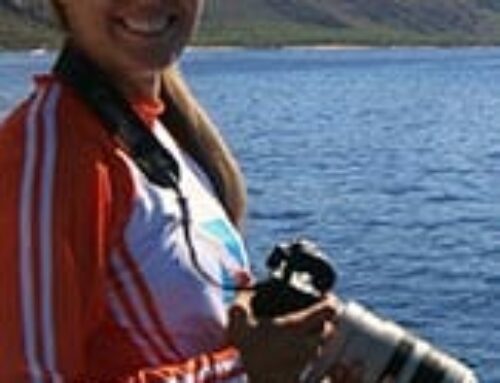Pelagic Birdwatching (Seabirds)
Wildlife Tours with Integrity, O’ahu
Seabirds spend most of their life feeding and living on the open ocean, coming to land only to breed or nest. Hawaii has productive, food-rich waters that make it a major foraging area for thousands of seabirds such as albatross, terns, boobies, shearwaters, petrels, tropicbirds, and other offshore species. Nearby islands and small atolls also create important nesting habitat for the many migratory and resident bird species.
An estimated 15 million seabirds of 22 species are either flying over Hawaiian waters or breeding on Hawaiian islands at any one time. Still, these birds can be hard to spot because their true home is the open ocean. Get out to sea them on our Full Day pelagic birding tours.
Seabirds are made for life on the ocean, gliding on the wind, drinking sea water and eating fish and squid. Some birds remain at sea for years at a time, spending most of their time on the wing. The majority mate for life and return to the same area each year to raise their young. Males and females of most species look similar. Both share parenting duties.
Of Hawaii’s 22 species, two are found only in Hawaii. These seabirds — the dark-rumped petrel and the Newell’s shearwater — breed only in the main islands and are listed under the Endangered Species Act. Most of Hawaii’s other seabirds breed in the predator-free islands of the Northwest Hawaiian Islands chain.
Love on the Rock…
We are nearing the end of mōlī / Laysan Albatross season! Fledglings taking the first flights and leaving the nest in July. Since November when the adults returned from sea, we’ve viewed the mōlī nesting site at Ka’ena Point from our boat tour (often under their flight path!). Only a couple more months to view these endemic “Goony Birds” on one of the very few nesting grounds here on the main islands of Hawaii. The Hawaiian Monk seals (highly endangered and also endemic) are also hauling out and giving birth in the area.
Culturally Speaking
Excerpted from Conservation Hawaii’s “‘E Mālama Nā Manu Kai O Hawai‘i Nei”:
Hawaiians watch the flights of seabirds to locate schools of fish, to help forecast the weather, and to locate islands when out at sea. Birds such as the manu o Kū are sometimes referred to as a navigator’s best friend because they occur in higher densities closer to islands and will lead a weary navigator home. Early Polynesians probably watched the flight patterns of migrating seabirds before setting sail to distant islands.
Hawaiian mythology includes stories of tropicbirds and ‘iwa being used as messengers for their gods. Feathers of tropicbirds and frigates also adorn Hawaiian kāhili (feather standards) and ‘ahu ‘ula (feather capes), and lei.
Hawaiians once relied on seabirds as a food source. Seabird eggs were eaten and the birds were prized for their oily flesh, which tasted of squid. To catch the young petrel and shearwater chicks in their burrows, Hawaiians used smoke to disorient and disable flocks of adults flying to and from the nesting colonies.
Although seabird numbers on the main Hawaiian islands are far lower than they once were and they have lost most of their nesting grounds, there are signs of hope. Small populations of ‘ua‘u recently have been found on Lāna‘i and Hawai‘i, and mōlī have been successfully nesting on Kaua‘i and O‘ahu for the last 25 years – at sites where mammals are excluded and controlled. All seabirds are protected by the Migratory Bird Treaty Act.
Oahu Natural Area Reserve we can observe during your charter
Ka`ena Point
One of the largest seabird colonies in the eight main Hawaiian Islands is found here. Recent surveys have estimated approximately 2,000 seabirds use Ka‘ena Point as their breeding grounds, and many more than that use the area as a place of refuge. Home to nesting seabirds, monk seals, and other native coastal species. One of the rare places the Laysan Albatross (mōlī ) nest on the main islands. Other nesters included the Wedge-tailed Shearwater (‘ua ‘u kani) and the White-tailed Tropicbird (koa‘e ‘ula).
In Hawaiian, kaʻena means ‘the heat’ – and reportedly named after a brother or cousin of Pele who accompanied her from Kahiki. The State of Hawaiʻi has designated the point as a Natural Area Reserve to protect and encourage the nesting of the Laysan Albatross and the native strand vegetation (11 federally endangered species!). Within the reserve is leina a ka ‘uhane (Spirit Leap), which is considered to be a wahi pana, a celebrated legendary place. Early Hawaiians used Ka‘ena Point for fishing and feather collecting.
It can be reached by foot, but is a bit of a hike due to it really is hot there – or muddy (stick to your slippers kind) during cooler winter months. We can easily view this area by boat, but be sure and mention that it is ‘on your list’ as we may head off a different direction depending on what all is going on that day, or what guests are interested in.
Mānana Island is a 63 acre volcanic tuff cone island. It is about 2300 feet long and 4200 feet wide. rises to about 360 feet at its highest point. There is a small beach on the southwest side of the island that is approximately thirty feet wide.
Today the island is a protected bird sanctuary and during the spring and summer the island is a breeding area for thousands of sooty terns, brown noddies., wedge-tailed shearwaters, bulwers petrels, adn red-tailed tropic birds. Mānana Island is a protected bird sanctuary and therefore it is not legal to land there unless you have permission from the Hawaii Department of Land Natural Resources.
Moku Manu Islets Seabird Sanctuary consists of two islets that totals 16.6 acres located off of Mōkapu Peninsula. Moku Manu is home to the most diverse and one of the densest seabird colonies in the Main Hawaiian Islands. Seabird species such as Wedge-tailed Shearwaters (ʻUʻau Kani), Black Noddy (Noio), Brown Noddy (Noio kōhā), Bulwer’s Petrel (ʻOu), Red-tailed Tropicbirds (Koaʻe ʻula), Sooty Terns (‘Ewa ʻEwa), Great Frigatebird (ʻIwa), Christmas Shearwater, Grey-backed Tern (Pākalakala), various Booby species, and various common shorebird species.
It has a relatively flat top, averaging about 165 feet in height but running up to 202 feet. The cliffs of Moku Manu drop directly into the sea around more than half of the island. Moku Manu is difficult to access and is closed to the public due to its status as a Seabird Sanctuary. However, activities like scientific research, conservation management, or subsistence, traditional, and customary practices by Native Hawaiians consistent with the long-term preservation of the wildlife sanctuary resources may be possible with a permit.
Nā Mokulua are part of the Hawaii State Seabird Sanctuary and activities on them as well as off-limit areas on them are regulated by law. Specifically, the smaller islet, Moku Iki, is off-limits to visitors, as is the interior of Moku Nui. Also, no pets are allowed. Many birds nest in ground burrows on the islands.
Mokulua Islets Seabird Sanctuary is composed of two islets, the larger northern islet, Mokulua Nui and smaller more southern islet, Mokulua Iki. Both islets are home to Wedge-tailed shearwaters (‘Ua’u Kani) for nesting. Along with that, other shorebird and seabird species can be seen there. These offshore islets are accessible to the public, but visitors are encouraged to stay below the high water line to reduce the chance of trampling seabird burrows.
Popoia, also known as Flat Island, is 4 acres in size and reaches a maximum elevation of 10 feet. True to its common name, the limestone islet is like a tabletop, although the surface is pitted with sink holes often used by nesting seabirds. It lies about 350 yards offshore from Kailua Beach Park in Kailua Bay on the windward coast of Oahu. The north, west, and south sides of Popoia are surrounded by a jagged reef. Visitors frequently land at the sandy cove on the southwest side. The ecosystem of the islet is vegetated coral which is utilized primarily by ʻuaʻu kani or Wedge-tailed shearwaters, ʻou or Bulwer’s Petrel, and pigeons. ‘Opae‘ula can also be spotted on this islet.
SELECTED BIRDS FOUND ON HAWAII’S OFFSHORE ISLETS
The following list highlights some of the most common bird species, especially seabirds, found in Hawaii’s offshore islets. There are, however, several species not included on this list. Each species is classified as either endemic, indigenous, or introduced.
Bishop Museum Offshore Islet Project There are at least 54 islets that lie offshore of the main Hawaiian Islands. These islets are uninhabited and mostly located within 10 km of the coast. They act as preserves for species and ecosystems that have been lost or are disappearing from the main islands. Although Hawaii has only 0.2% of the land areas of the U.S., 75% of the species historically documented to have gone extinct in the U.S., and 33% of the nation’s endangered species are endemic to Hawaii.
